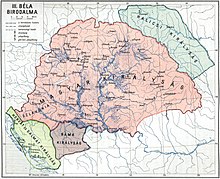
Back Галіцкае княства Byelorussian Principat de Galítsia Catalan Haličské knížectví Czech Fürstentum Galizien German Principado de Galitzia Spanish Galiitsia vürstiriik Estonian شاهزادهنشین هالیچ Persian Principauté de Galicie French Galička Kneževina Croatian Principato di Halyč Italian
| Principality of Galicia Галицкоє кънѧжьство | |||||||||||||
|---|---|---|---|---|---|---|---|---|---|---|---|---|---|
| Principality of the Kievan Rus' | |||||||||||||
| 1124–1199 (1205–1239) | |||||||||||||
 Halych Principality in the 12th century | |||||||||||||
| Capital | Halych | ||||||||||||
| History | |||||||||||||
• Succeeded from Peremyshl-Terebovlia Principality | 1124 | ||||||||||||
• United with Volyn Principality | 1199 (1205–1239) | ||||||||||||
| Political subdivisions | Principalities of Kievan Rus' | ||||||||||||
| |||||||||||||
| Today part of | Poland, Ukraine, Romania, Moldova | ||||||||||||
The Principality of Galicia (Ukrainian: Галицьке князівство, romanized: Halytske kniazivstvo; Old East Slavic: Галицкоє кънѧжьство, romanized: Galickoje kǔnęžǐstvo), also known as Principality of Halych or Principality of Halychian Rus',[1] was a medieval East Slavic principality, and one of the main regional states within the political scope of Kievan Rus', established by members of the oldest line of Yaroslav the Wise descendants. A characteristic feature of the Galician principality was the important role of the nobility and citizens in political life, and consideration a will which was the main condition for the princely rule.[2] Halych as the capital mentioned in around 1124 as a seat of Ivan Vasylkovych the grandson of Rostislav of Tmutarakan. According to Mykhailo Hrushevsky the realm of Halych was passed to Rostyslav upon the death of his father Vladimir Yaroslavich, but he was banished out of it later by his uncle to Tmutarakan.[3] The realm was then passed to Yaropolk Izyaslavich who was a son of the ruling Grand Prince Iziaslav I of Kiev.

- ^ Larry Wolff (2010): The Idea of Galicia (p. 254-255)
- ^ Майоров А. В.. Галицко-Волынская Русь. Очерки социально-политических отношений в домонгольский период. Князь, бояре и городская община. СПб., Университетская книга. 640 с., 2001
- ^ Грушевський. Історія України-Руси. Том II. Розділ VII. Стор. 1.

